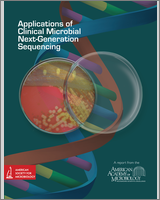SECTION 5FINDINGS AND RECOMMENDATIONS
Key Finding 5.1 Establishing NGS capabilities in a clinical microbiology laboratory requires a significant financial outlay. Purchase of an NGS platform is only one component of the cost, and often underemphasized is the requirement for essential NGS hardware and accessory equipment. Bioinformatics expertise will be essential until the “easy button” is implemented.
Key Recommendation 5.1 To help minimize the cost and bulkiness of NGS hardware implementation, the utility of benchtop and point-of-care (field-able) sequencing platforms should be emphasized for clinical laboratories seeking to engage in this space. These sequencing systems consume less space and are generally less expensive than larger NGS platforms, and data analysis can be completed on a high-end desktop server or even a laptop.
Key Finding 5.2 NGS data need to be distilled into a clinically actionable result. This wealth of data can be made clinically relevant by identifying genotypic resistance mechanisms and genes encoding virulence factors. Deployment of NGS will require substantial validation of genotypic prediction of the AMR phenotype; however, there is limited precedent for this work.
Key Recommendation 5.2 Some NGS-based assays, e.g., metagenomic assays, are capable of returning a complex set of results that require careful interpretation by the clinical microbiologist to determine what is clinically actionable and what should be included in the results report to ensure optimal patient care. For example, NGS results should assist the physician in determining what antimicrobial can be used rather than what drugs the organism is resistant to or what drug is not suitable for treatment. The presence of the gene conferring AMR is not evidence of its expression and hence AMR phenotype. There needs to be a way to phenotypically verify the genotypic result generated by NGS. Rapid phenotypic testing methods are currently under development.
Key Finding 5.3 Concerns over patient privacy and confidentiality of NGS genomic data remain an issue.
Key Recommendation 5.3 When NGS data are to be stored remotely, such as on a server, in the cloud, or within a database, the information must protect patient privacy and be HIPAA compliant.
Key Finding 5.4 All of the files associated with a whole-genome NGS run represent an enormous amount of data requiring significant storage space.
Key Recommendation 5.4 The raw sequence reads, .FASTQ files, and the complete genomic sequence of the identified pathogen would consume considerable storage space for the hospital. The assembled sequence should be uploaded to an appropriate database, and only the clinically relevant result should be maintained in the patient's electronic medical file.
